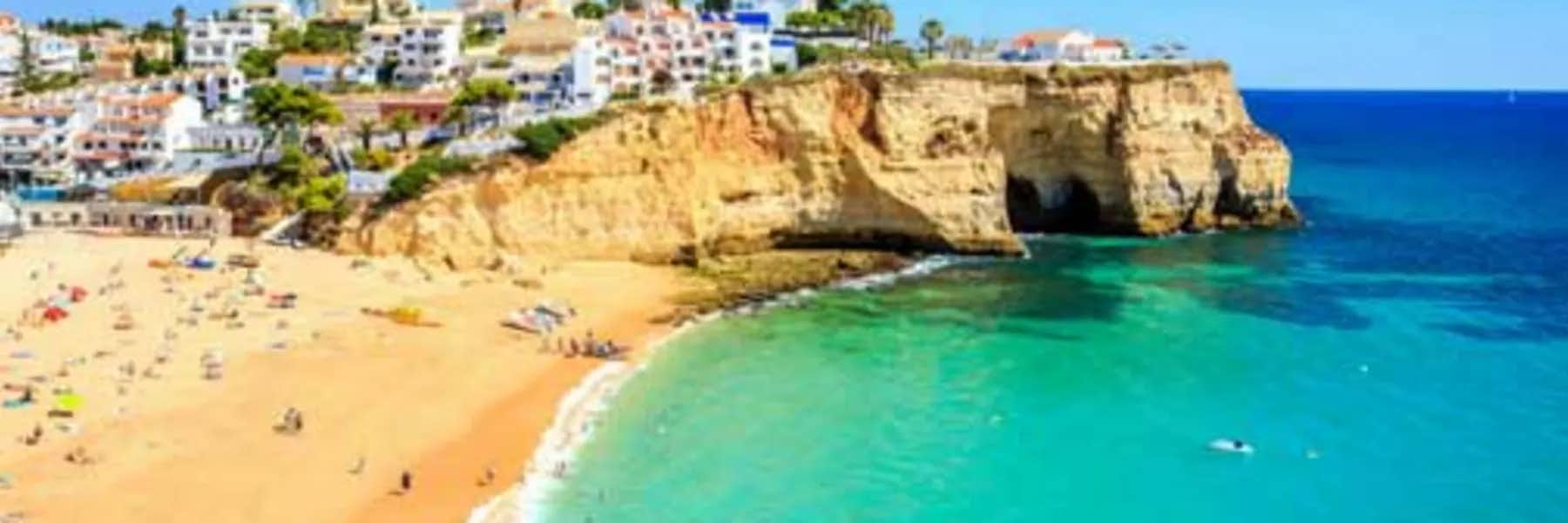The British discovered long ago the delights of Portugal, from the mellow taste of port wine in the north to the natural beauty of the southern region known as the Algarve. Over the years this area has also attracted Northern and Central Europeans seeking to escape cold climates. Now it’s gained momentum with travelers and expats from the U.S., Canada, Australia, and elsewhere. Why?
From the craggy cliffs and expansive views afforded by Cape St. Vincent on the extreme west coast to Tavira—sometimes referred to as “Queen of the Algarve,” located 30 minutes from the Spanish border—the region is rich in every way.
Superior beaches, ancient architecture, cuisine noted for fresh seafood—like the regional dish, cataplana—and excellent, inexpensive wines are luring many to explore the Algarve. In fact, in 2021, nearly 3 million tourists chose it as a destination.
The smallest administrative division on mainland Portugal, the Algarve is bordered by the Alentejo region on the north, the Atlantic Ocean on the west and south, and Spain on the east. It encompasses 1,930 square miles and has 470,000 permanent residents.
The region is divided into 16 municipalities. (A note about terminology: designations can be confusing even for the Portuguese, so don’t worry about whether the names that follow are districts, cities, counties (concelhos), or towns. If you want to visit one—or all—of them, you’ll have no difficulty, as they are all well-known.)
Get Your Free Portugal Report Today!
Get Your Free Portugal Report Today!
Discover why we love a slower pace of life in Portugal and info on other European countries in our daily postcard e-letter. Simply enter your email address below and we’ll send you a FREE REPORT – Explore the Old World in Laidback Portugal.

By submitting your email address, you will receive a free subscription to IL Postcards, Overseas Dream Home, The Untourist Daily and special offers from International Living and our affiliates. You can unsubscribe at any time, and we encourage you to read more about our Privacy Policy.
Loulé, a traditional Portuguese market town, is the largest municipality with a population of 62,300. It’s followed by Faro (41,355), home to an international airport, Portimão (44,818) where you’ll find Praia de Rocha, a stunning beach backed by ochre-hued cliffs, and Albufeira (37,244), a former fishing village with a busy marina and active nightlife.
Smaller in population but not in desirability are Lagos (15,388), which also offers glorious beaches and lively bars and restaurants, Tavira (25,000), with a castle overlooking a seven-arched Roman bridge and no less than 37 churches, and Lagoa (23,835), home to the most productive winery in the Algarve.
Retire in the Algarve
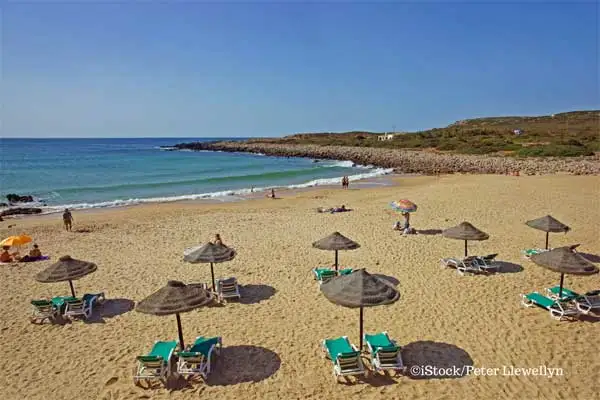
If you’re considering this region as a retirement location and maintain an active lifestyle, you won’t be bored. Despite 100 miles of Atlantic shoreline, there’s plenty more to do than sunbathing. Golfing, tennis, boating, horseback riding, hiking, and biking are just some of the opportunities.
Explore Albufeira’s Archeological Museum, with artifacts from the Stone Age through the Roman and Moorish occupations to the 17th century.
Take a river cruise from Portimão to Silves, the former Moorish capital of the Algarve, which is nestled in a hillside surrounded by lemon and orange groves.
Stroll cobbled streets and climb the castle ramparts. While you’re up there, look for some of the town’s famous locals, the Great White Stork. Learn about Prince Henry the Navigator in Sagres, or the sardine canning industry in Portimão, or soak in the spa at Monchique.
Lifestyle in the Algarve
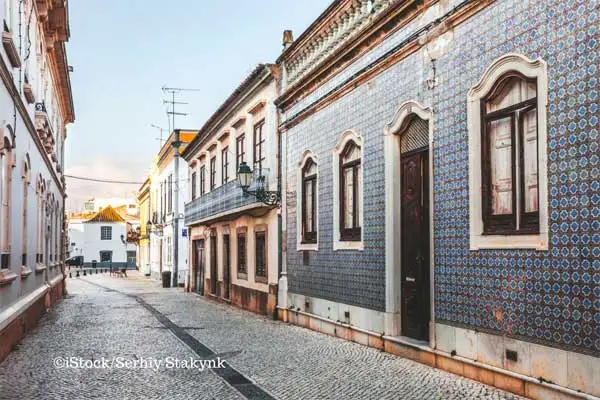
The Algarve has some of the best weather in all of Europe with over 300 days of sunshine, hot dry summers, and mild winters. Summer temperatures average around 87 F, in the fall they dip down to mid to low 60s F, and winter brings some rain with temperatures hovering around 59 F.
In the west, near Lagos Atlantic winds buffet towering cliffs and generally keep the air four or five degrees cooler than in the east, near Tavira.
The choice is yours: do you want a beach with dramatic geological formations, or would you rather stretch out on sandy protected coves? The sheltered bay in Monte Gordo close to the Spanish border is said to have the warmest water in all of the Algarve.
As far as language is concerned, generally you can get by in English. The key is “get by.” If you want to venture into the Algarve’s authentic, sparsely inhabited, interior villages and savor the true flavor of the country, learn at least some Portuguese.
Portuguese is a romance language, very similar to Spanish or Italian, and not any more difficult to learn. Just be sure to study European or Continental Portuguese and not the Brazilian version since the latter is very different. It’s a welcome sign of respect to attempt to speak to locals in their native tongue. They’ll love you for it. And then they probably will want to practice their English.
Another consideration is your preferred surroundings. Perhaps a bustling tourist town offering many activities and English-speaking locals is appealing. (But beware of the months of July and August when tourism peaks.) Or maybe you seek a quieter lifestyle in a more rural setting?
Below are three suggestions representing a few popular expat havens in the Algarve but there are many more to consider.
Tavira
Dip your toes into the lazy Gilão River that runs through the center of this historic, charming city or hop aboard the ferry to Tavira island for a walk on the beach. Its old-town shines with colorful tiled buildings and the remnants of a castle from days gone by. Meander along the cobbled lanes packed with cafes and restaurants where surely you will hear English being spoken by the many foreigners who call this adorable city home.
Vilamoura
Originally conceived in the 1980s as a world-class golfing venue, Vilamoura offers elegant hotels, fine dining, and a large marina complex in addition to the pristine Praia da Falésia beach. For a more traditional Portuguese feel, Quarteira is only steps away with a local fish and produce market. A short drive to Loulé, to mingle with locals at the Arabic-inspired market or stroll around the historic center.
Lagos
History abounds in this coastal walled city with its 17th-century fort, a lively marina complex, and narrow cobbled lanes. Nearby is the stunning coastline of Ponta da Piedade where boardwalks descend to the clear blue water that is decorated with craggy rock formations, caves, and grottoes. Also, home to a sizeable expat community, plenty of restaurants, cafes, and tourists’ shops that line the marina complex.
Get Your Free Portugal Report Today!
Get Your Free Portugal Report Today!
Discover why we love a slower pace of life in Portugal and info on other European countries in our daily postcard e-letter. Simply enter your email address below and we’ll send you a FREE REPORT – Explore the Old World in Laidback Portugal.

By submitting your email address, you will receive a free subscription to IL Postcards, Overseas Dream Home, The Untourist Daily and special offers from International Living and our affiliates. You can unsubscribe at any time, and we encourage you to read more about our Privacy Policy.
Cost of Living in the Algarve
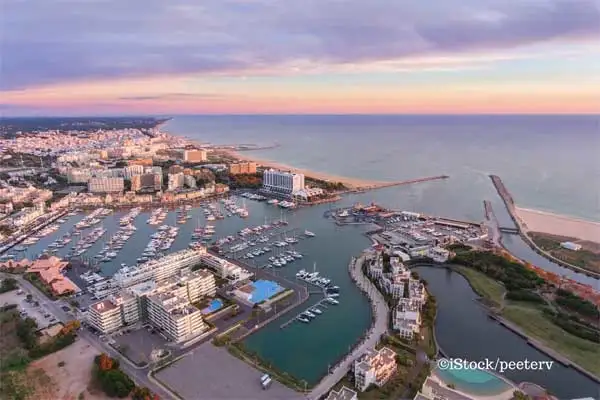
Housing is the primary cost factor to living most anywhere, and while Portugal’s popularity has increased prices in recent years deals can still be found.
For example, it’s possible to find a two-bedroom home for sale in Portimão for $219,000, in Albufeira for $299,000, and in Tavira for $275,000. In the same three cities, two-bedroom monthly rentals can be found from $800, $1,000, and $1,000.
Here’s the average purchase price per square foot in three of the prime areas referenced above.
| CITY | COST PER SQUARE FOOT |
|---|---|
| Lagos | $312.61 |
| Faro | $231.51 |
| Tavira | 246.51 |
The following monthly budget is based on the cost of living for a couple living in a coastal city in the Algarve. Being a popular holiday spot means rental prices are higher here than in other parts of Portugal.
Beaches, History, and Charm: 5 Must-See Algarve Towns
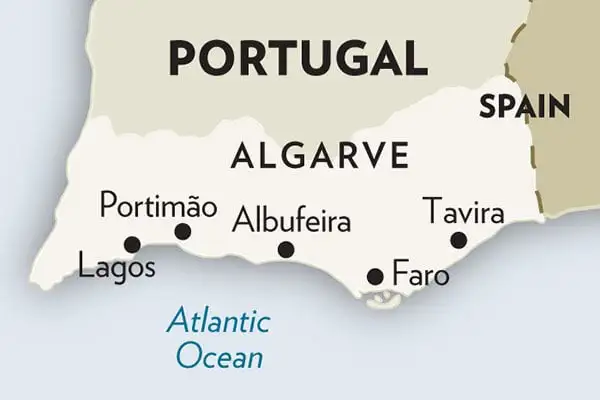
| ITEM | COST |
|---|---|
| Housing (rent for a furnished two-bedroom apartment) | $1,000 to $2,000 |
| Internet/Wi-Fi/Phones | $75 |
| Utilities (Gas, water, electricity, trash) | $150 (depending on season and usage) |
| Groceries | $400 |
| Entertainment (dining out twice per week; cultural activities) | $400 |
| Household help (maid twice per month, three hours per day) | $60 |
| Health Insurance – Required for Residency Visa (Cost will increase with age, pre-existing conditions and how comprehensive the policy may be) | $150 |
| Transportation Car or public transportation | $300 |
| Incidentals | $200 |
| Total: | $2,735 to $3,735 |
By Tricia Pimental
Portugal’s appeal, for most expats, begins with the Algarve. That’s the southern stretch of the country running from craggy Sagres in the west to the low-lying Spanish border in the east. It is a region of wild coastline interspersed with some of the best beaches in the world.
This region of Portugal has earned its reputation among expats by providing a resort feel, while at the same time maintaining the authenticity of this beautiful country. Scores of golf courses, from easy to award-winning, stud the coastline.
The dining scene ranges from simple, local food at small cafés in each town to the Michelin-starred Vila Joya in Albufeira. In fact, a total of seven restaurants in the region earned Michelin stars in 2018.
The architecture reflects the region’s 500 or so years of Moorish influence between the eighth and 13th centuries. Even the name, Algarve, derives from the Moorish Al Gharb (“western cape”). The towns are typical medieval historic centers with narrow, winding cobbled streets.
Traditional houses are white with yellow or blue borders and thick stone walls to protect from summer heat. Layered into all this history are vestiges of the Roman Empire, including first-century Roman ruins like the ones outside Faro, at Estoi.
The people are helpful and super-friendly.
Medical care is the same as it is all over Portugal: available at very affordable prices, or even free, depending on one’s residence status.
Real estate ranges from simple studios along the coast to villas with sweeping panoramic views in the surrounding hillside towns. It’s easy to drive around, with excellent highways and municipal roads. Let’s take a trip to some of my favorite towns in the Algarve.
Lagos
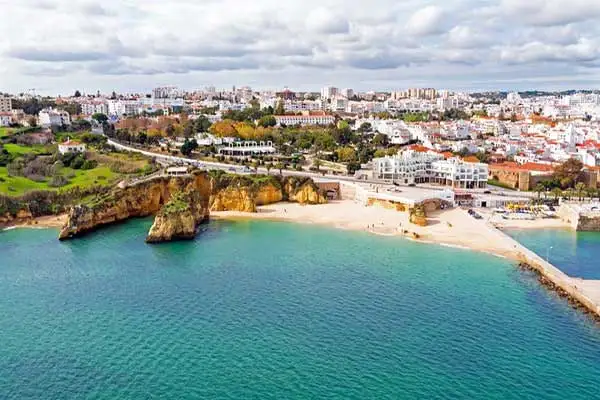
“You ever have one of those ‘pinch yourself ’ moments, when everything aligns and you feel you’ve arrived? That’s the feeling I wake up to every day in Portugal.”
On a sunny autumn afternoon, Mike Sager sits at a British-style pub in the town center of Lagos. Souvenir shops and eateries line the surrounding cobblestone streets. Close by is a plaza where buskers sing classics from the ’60s and ’70s. Dressed in a t-shirt, boardshorts, and flip-flops, the native of Huntington Beach, California, eases back in his chair and tells me why Lagos is now home.
“I’ve lived in Ecuador and Panama, and now I’ve been here for almost three years. My Portuguese is marginal, but basically, everyone speaks English. The people are helpful and super-friendly.”
Lagos is in the western Algarve, where the beautiful rock formations of Ponta da Piedade and inviting sands lure beach lovers, while a large number of bars, cafés, and restaurants offer food and beverage choices for all.
You can have a Portuguese breakfast at a local hangout across from the marina for a couple of dollars, with coffee and thick-sliced local bread toasted and dripping with butter.
Another plus is the Algarve’s weather. Summer temperatures range from around 68 F to 82 F and drop by 20 F in winter on average.
Yet another is the professional healthcare. In addition to clinics, the Hospital São Gonçalo de Lagos has experienced medical staff offering inpatient and outpatient care, lab work, imaging, and surgical services at affordable prices.
An impressive new construction project on the waterfront will offer spectacular views of the harbor, but with a commensurate price tag: Average prices are $399,000 and up for two- or three-bedroom apartments. Prices relax a bit just 10 minutes from the town center, in the hills surrounding Lagos, where white, terracotta-topped houses and bougainvillea-draped duplexes suggest low-key suburban life.
Portimão
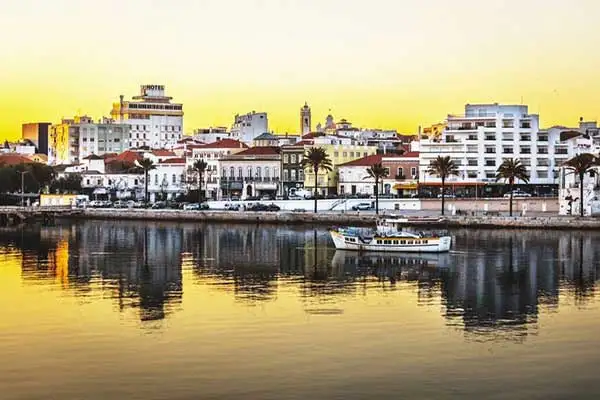
Thirty-five minutes east is Portimão, with a population of 55,000. The ambience is low-key compared to Lagos, this is more a working-class Portuguese type of town, although I overheard Dutch, German, and French spoken. These latter contribute to the international flavor of this former shipbuilding and sardine-fishing hub. Businesses were already beginning to close at around 7 p.m., but I did come across a vegetarian restaurant serving chickpea falafels and organic beer and wine, a pleasant alternative to the usual fish and meat menus available. A relaxing dinner here at one of the street-side tables will set you back a reasonable $25 for a starter, main course, and glass of wine for two.
It was almost sunset when I made my way to the Ribeirinha, where former jetties along the Arade River have been transformed into a pleasant promenade leading to a spacious garden and fountain area. Pizza places, ice cream parlors, and restaurants entice passers-by. I noted with delight that the bridge leading to Ferragudo— where I spent the night—was strung with lights in the shape of a fish, a reminder of Portimão’s historic roots.
One draw to this town as a vacation spot is that it’s less than two miles from one of the Algarve’s most famous beaches, Praia da Rocha, although the resort is rather overbuilt. Portimão lacks the traditional charm that so many other cities in the region retain—and it offers only modest health services.
It’s not a location I’d settle in. Having said that, if you have an eye to purchasing for investment, you might do well in this area. A sun-drenched three-bedroom house, three miles from Portimão, is selling for $226,700 or renting for $1,600 a month.
In high season, the rule of thumb is that a week’s rental equals one month’s off-season rent.
The house is also near one of my favorite small towns, Alvor, home to photographers Matt Ashwell and Lena Roganovic. “We rent a nice, affordable apartment that takes up roughly half our monthly budget of $1,700,” Lena says. “And we’re surrounded by amazing beaches, cliffs, and coves.
We stroll down to the harbor, or along a boardwalk over miles of sand dunes and wild, golden fields. The Monchique mountains are in the distance. It’s absolutely beautiful.”
Albufeira
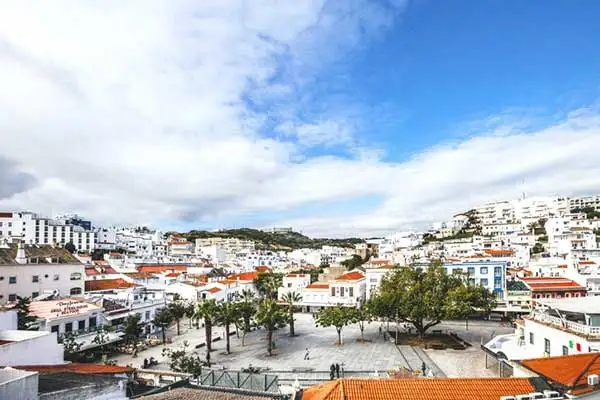
Another 30-minute drive east lies Albufeira, probably the best-known city in the Algarve, with around 15 miles of beaches.
This is a party town, framed in cobbled streets, winding alleys, and Moorish-influenced architecture, with over 100 bars, cafés, and restaurants in the old town alone. The main square, Jardim Público (Public Garden), is any shopper’s fantasy. Lovely boutiques offer arts and crafts, fine jewelry, pottery, woolen goods, and more.
Real estate agent Leonardo Pereira says that in the off season (October to June) you can find a three-bedroom furnished apartment for about $900, plus utilities. It’s possible to secure an eight-month contract in off-peak season. That is important when applying for a four-month visa, as you’re required to show a signed lease.
A two-bedroom, 1,184-square-foot, apartment with sea and marina views and use of two saltwater communal pools is currently available for $1,120 a month.
Faro
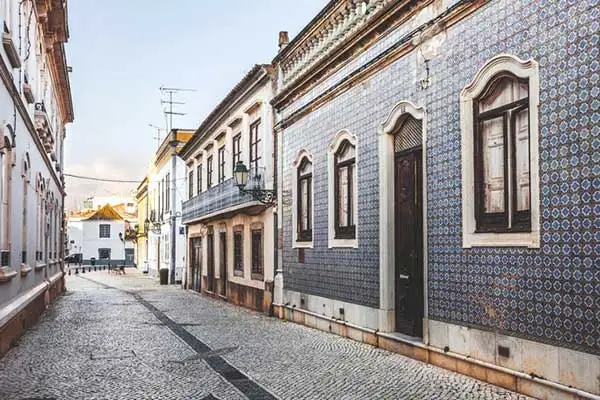
Faro is the region’s largest city. It’s not without charm, but don’t come here if you’re looking for the quintessential Portuguese town or beach experience: There’s a city feel here, and it requires some work to access area beaches.
I parked my car near the impressive, ancient city walls. This place is full of history and it’s difficult to go very far without a reminder of its Roman and Moorish past, as well as references to the discoverers.
I toyed with the idea of taking a trip to Ria Formosa Natural Park to view sandbar islands, saltwater lagoons, and protected wildlife. Meanwhile, I opted for a dinner of salmon salad and beef carpaccio at The Moose (a grand total of $30).
In a prime location in Faro, a two-bedroom apartment with a large kitchen and free parking was for sale for $226,500.
Faro is perhaps not an ideal retirement location, but there are reasons to use it as a base for exploring the Algarve, one being its international airport.
Rentals cost a bit more in this city, as it is the commercial center of the Algarve. A four-bedroom apartment with luxury amenities costs around $1,700 a month. But you will be 15 minutes from the airport and have all the conveniences of a city.
Tavira
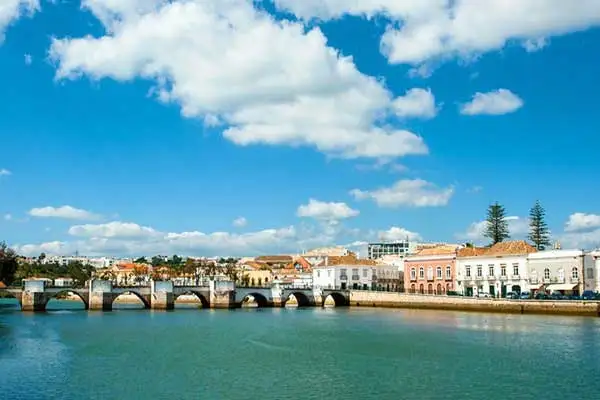
Continuing east is Tavira, one of the prettiest little cities I came across. The town straddles the Gilão River and features whitewashed buildings, Roman ruins, and jacaranda and oleander blossoms everywhere. Touches like latticework doors with knockers in the shape of hands (a tradition passed on by the Moors) add to the charm.
I hopped on a ferry to Ilha Tavira, one of the finest beaches in the Algarve.
To my surprise, there were not only cafés, but a number of good restaurants. Vendors sold handicrafts at tables on the way to the wooden boardwalk, which leads to a stretch of pristine sand.
There’s no way around the real estate situation here: The odds are strongly against finding an affordable house to rent. And it’s hard to find one to buy for under $200,000. But if you’re willing and able to spend a bit more, you might have luck in an urbanização, a designated community usually surrounding small cities, consisting of apartment complexes.
For example, a two-bedroom, sea-view villa in excellent condition, located in the Mato Santo Espírito Urbanização five minutes from Tavira town center, sells for $219,000. Monthly rental: $1,850.
Get Your Free Portugal Report Today!
Get Your Free Portugal Report Today!
Discover why we love a slower pace of life in Portugal and info on other European countries in our daily postcard e-letter. Simply enter your email address below and we’ll send you a FREE REPORT – Explore the Old World in Laidback Portugal.

By submitting your email address, you will receive a free subscription to IL Postcards, Overseas Dream Home, The Untourist Daily and special offers from International Living and our affiliates. You can unsubscribe at any time, and we encourage you to read more about our Privacy Policy.
